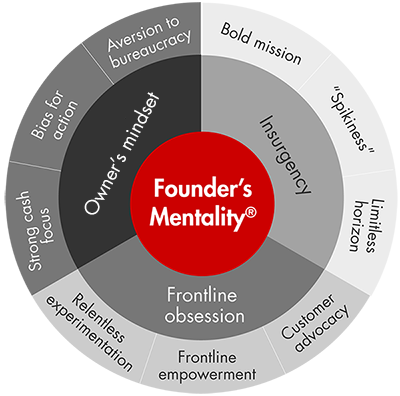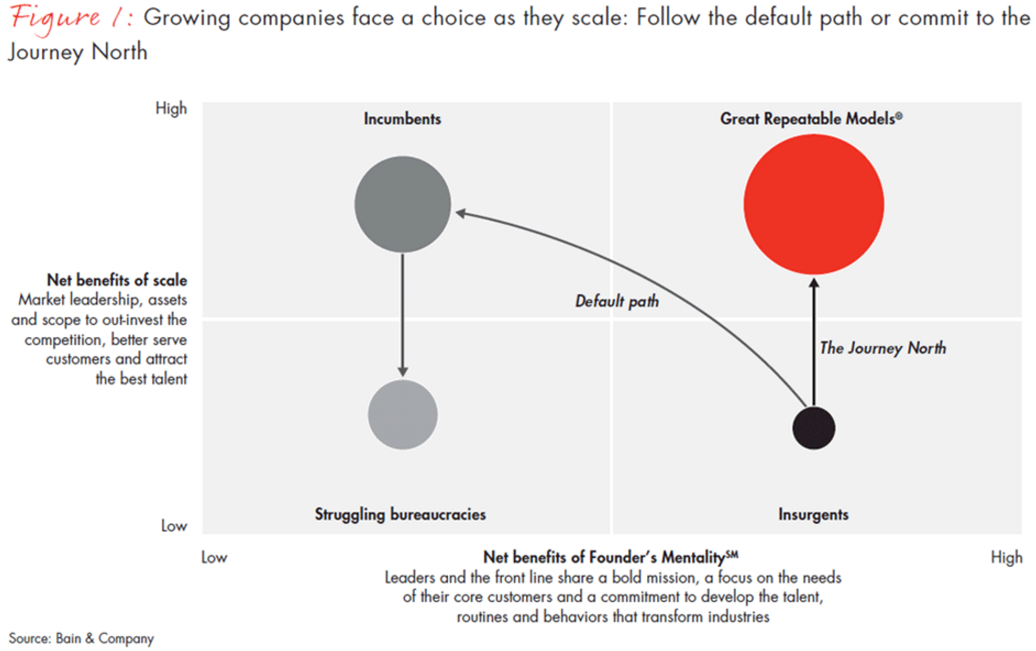
The Founder's Mentality
How to Overcome the Predictable Crises of Growth
by Chris Zook, James Allen
Read Status: Completed 📕
Last tended 4 years ago
Planted 4 years ago
Evergreen 🌳
Tags: STARTUP, GROWTH, ENTREPRENEURSHIP
6 min read ☕️
Table of Contents
How I Discovered It
I devoured this book during my first week at a high-growth startup. Part of the reason I chose this startup is that I am attracted to its potential and its growth story. The company is currently in the phase of regional expansion. Scaling, in Elon Musk’s words, is extremely difficult.
Challenges come with opportunities. I believe my time and experience in this company will broaden my perspective and benefit my career in the long run.
Summary
This book aims to share practical ideas for achieving sustainable growth in a short time frame, as compared to engineering a five or seven plan to create deep cultural change.
The authors share similar sentiments as Elon Musk on the topic of growing companies. The authors call it, "the paradox of growth."
Growth creates complexity, and complexity is the silent killer of growth.
Barriers to profitable growth are both internal and external. Today, most businesses face at least one form of external disruption to a part of their business model or market in the form of a substitute product or service, a major shift in the profit drivers of the industry, or a fundamental change in customer needs or buying behaviors. More importantly, 4 in 5 of these problems can be traced to internal problems - problems that inhibited its ability to adapt, decide and act quickly, embrace new ideas, keep costs down, or scale its ability to serve customers.
Internal problems are harder for leaders to manage, and they can be classified into 3 internal crises; overload, stall-out and free fall.
The search for full potential is a central theme that connects the authors' books: full potential in the core (Profit from the Core), full potential in surrounding adjacencies (Beyond the Core), full potential in businesses whose models are becoming obsolete but still have assets to build on (Unstoppable), and full potential in the adaptable, repeatable business model (Repeatability), search for full potential from mastering its internal game (The Founder's Mentality).
Key Ideas
The Founder's Mentality
The Founder's Mentality begins with a bold, ambitious founder who got it right the first time. It is a key source of competitive advantages for young companies (the insurgents) going up against incumbents.
3 Main Traits of the Founder's Mentality

There are 3 main traits:
- Insurgent's mission: the belief that the company is not simply selling products but is at “war” with an industry stuck in the past or underserving customers.
- Owner's mindset: everyone in the company have a vested interest in the success of the company
- Obsession with the frontline: an intense focus on the customer
Research shows that companies that exhibit these attributes perform 4 to 5 times better than the rest.
The Founder's Mentality Map

Most companies start from the bottom right. Business leaders should strive for the top right quadrant; scale insurgency. Scale insurgents are companies that managed to retain their insurgency while building market power and influence. Think Google, Haier, Apple, and IKEA.
Companies could also grow to be incumbents but they lose the entrepreneurial energy and flexibility of the founder’s mentality as they scale. These companies can be illustrated on the top left quadrant. The authors listed companies such as Microsoft, Unilever and SAP as examples.
It is important to note that many companies don't exist at the extremes but drift around the middle of the matrix; a position troubled by waning market power and internal dysfunction born of complexity and bureaucracy.
2 Ways to Gauge a Company's Success
A company's success can be understood from its internal and external narratives.
The external story is the most visible and easiest to track. It comes in the form of quarterly earnings, market share and profitable growth. It shows how a company wins on the outside by serving the customer better than its competitors.
The inside story is less obvious. As the authors put it, "It’s the story of building the business, expanding and retaining a quality workforce, strengthening the culture, upgrading the systems, learning from experience, adapting the business model, holding down costs, and mobilizing the people to carry it all out perfectly, again and again."
3 Internal Crises of Growth
The authors identified 3 crisises that adversely affects the company internally; overload, stall-out and free fall.
The causes of overload and stall-out are mostly from internal problems. The authors call them the westward winds and southward winds. Free fall tends to be caused by systemic dysfunction on the inside that prevents companies from adapting to profound strategic challenges on the outside. These external challenges are called threat storms.
Overload
- The internal dysfunction and loss of external momentum that management teams of young, fast-growing companies experience as they try to rapidly scale their businesses.
4 Causes of Overload (Westward Winds)
- The Unscalable Founder: the commited founder who finds himself out of depth as his company scales but he simply can't let go.
- Lost Voices from the Front Line: when there is huge inflow of overload, the managers may distance themselves from the front line.
- Erosion of Accountability: Blinded by new layers of bureaucracy and struggling with short-term demands of growth, poor short-sighted decisions may be made without direct accountability.
- Revenues Grow Faster Than Talent: As the company scales up, they need to staff up quickly and may sacrifice quality for quantity. Employees may lose touch the company's original mission. Newly hired higher-level executives may make disruptive changes to the founding culture.
Stall-out
- The sudden slowdown that many successful companies suffer as their rapid growth gives rise to layers of organizational complexity and dilutes the clear mission that once gave the company its focus and energy. Stall-out is a disorienting time for a company: the accelerator pedal of growth no longer responds as it used to, and faster, younger competitors are starting to gain ground. Most companies that stall out never fully recover.
4 Causes of Stall-Out (Southward Winds)
- Complexity Doom Loop: Every business begins with a single product. Growth begins and brings new opportunities, new customer segments, new geographies and new channels of growth. They are shiny objects - chasing them brings immediate results but they add complexity to the core mission. Unchecked complexity may kill growth by creating tired leaders.
- Curse of the Matrix: Businesses often organise employees based on function. As the department grows, departmental priorities may outweigh the sense of collective purpose. Politics, competing interests become intense. Decision making becomes sluggish. Resources get trapped in departmental silos.
- Fragmentation of the Customer Experience (CX): CX feels depersonalized. Nobody takes ownership of the issues that the customer may face. Employees only care about their own responsibilities and eager to pass the customer to another person to solve.
- Death of the Nobler Mission: Lose the shared sense of the orginial noble mission, you lose your company's soul. Employees become less engaged in their work.
Free fall
- The most existentially threatening. A company in free fall has completely stopped growing in its core market, and its business model, until recently the reason for its success, suddenly no longer seems viable. Time feels scarce for a company in free fall. The management team often feels it has lost control. It can’t identify the root causes of the crisis, and it doesn’t know what levers to pull to escape it.
Threat Storms
Free fall is an existential problem. Internal problems and unfavorable market conditions can lead to free fall.
Examples include:
- Product substitution
- Shift in profit pools
- Changes to business models
Fast Growth, Fast Stall-Out
The shift towards software and services is eroding the advantages of size. The barriers of entry are getting lower. However, the other side of the story is that, as the insurgents grow faster and earlier to become incumbents, they are also stalling out more often and more suddenly. This results in a rapid reordering of strategic positions in many industries. Leaders and followers are changing places speedily. This brings different challenges to the company's management.
Action Plan for Leaders
Setting the Foundations
- Leadership is learnable
- Leadership is not just for the CEO. The founder's mentality can be cultivated in leaders at every level in your organization.
- The founder's mentality is not just for successful companies. Companies in trouble can embrace the founder's mentality to navigate through internal crises.
- The attributes of scale insurgents are relevant for all business leaders.
3 Key Areas to Look Out for
Self-Awareness
- Companies tend to be good at assessing outcome measures such as profit, revenue and market share. However, they may neglect nonfinancial, root-cause measures.
- Leaders may be surrounded by their direct reports and miss out on the essential voices from the ground.
- The tyranny of the short term. Do not wait for a crisis before taking action.
Common Ambition
- Reach directly down into the organization.
- Great leaders simplify the message and impart their people with a very personal sense of mission.
Create a Compass
- When Paul Polman took over as the CEO of Unilever, he and his top managers created the "Compass", a document which consisted of a new purpose for the company, a high-level goal, and twelve nonnegotiable principles designed to create more cohesion and reduce complexity.
Essential Decision Tips
- Employ Janusian Thinking (Divergent thinking)
- Say no to say yes: the inability to say no to new opportunities that don't fit with the company's core mission (premature abandonment of the core business)
- Use the power of 10X: willingness to commit 10x resources to a project. Avoid consistent mediocrity by invest equally to good and bad businesses.
- Pursue the "hidden" root cause: use Five Whys
- Invest massively in next-gen leaders
- Invest preemptively in building new capabilities
- Focus on long-term goals and horizons
- Become guardians of speed and agility: eliminate hidden killers of speed as energy vampires and silos
- Share the burden of leadership across the organization: take ownership of problems
How to Use the Founder’s Mentality?
To help readers gauge their company's level of the Founder's Mentality, the authors have created The Founder’s Mentality® diagnostic survey.